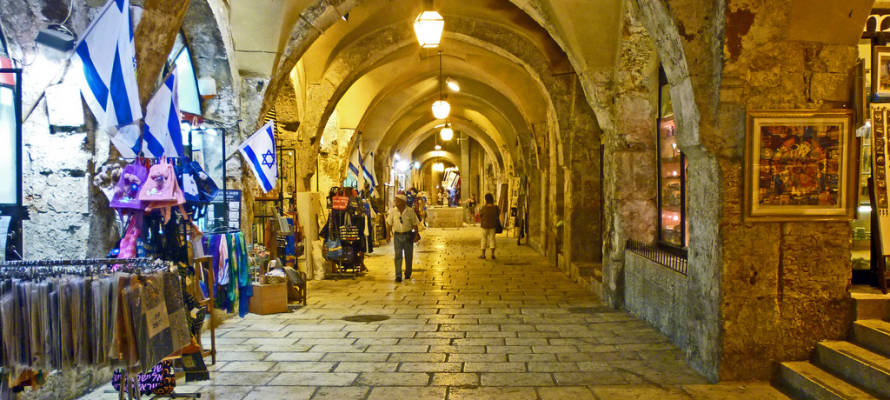
While the Romans may have had the upper hand nearly 2,000 years ago, all that remains of that civilization in the Old City is a road. Jerusalem is once again the undivided, eternal capital of the Jewish people.
In the Old City of Jerusalem, in the heart of the Jewish Quarter, runs the Cardo – the ancient marketplace from the Roman and Byzantine eras. The ancient Cardo actually links up with today’s modern marketplace, which is still referred to as the Cardo. As we stand in the Cardo, we can get a feel for what it may have been like to be there over 1500 years ago.
When the Romans destroyed the Jewish Temple and exiled the Jews in 70 CE, they subsequently attempted to transform Jerusalem into a typical Roman city. In every Roman city there was a north-south road running from one end of the city to the other in a straight line, known as the Cardo. Jerusalem, would be no different. A Cardo was constructed beginning at the Damascus Gate and extending to somewhere in the vicinity of Zion Gate. There was also an east-west road which was called the Decumanus Maximus.
Located in today’s Cardo is a beautiful, modern fresco depicting a typical market day in the ancient Cardo. If you have a sharp set of eyes you will be able to identify some interesting details in the painting. You will notice a boy from the modern era with a green knapsack, a red baseball cap and a bottle of water, standing next to a young Roman girl who is extending her hand with a pomegranate to the boy. The artist is depicting the continuity and fluidity of history. You will also notice, on the left side of the painting, that the artist painted into the picture Teddy Kollek, a long-time mayor of Jerusalem, archaeologist Nachman Avigad (who excavated the Old City) and the artist himself wearing Roman togas.
The Cardo was designed by the Romans as the main thoroughfare. There were shops on both sides of the road with awnings covering them. The awnings were supported by large, beautifully designed pillars of which a few are still standing today. Between the shops was the road where people would walk or ride their donkeys, horses or camels. The Cardo was a loud, colorful street with a variety of scents that filled the air.
Another noteworthy feature of the Cardo is a re-creation of an ancient map found in a church in Madaba, Jordan. The Madaba map shows us what Jerusalem looked like over 1,500 years ago. It was this map that enabled archaeologists to discover the Cardo and other sites in the Old City. Conspicuously absent is the Temple Mount, which had already been ransacked and destroyed by the Romans when the map was designed. Apparently nothing significant had replaced the Temple, as nothing appears on the map. It is amazing that you can still use this map to easily navigate your way around the city.
When you walk from the Armenian Quarter and enter the Jewish Quarter, one of the first things that you see in the expanse is the Cardo. While there were many segments of the Cardo that remained from the ancient Roman-Byzantine empire, it was this stretch of the Cardo that the archaeologists chose to remain exposed and enjoyed by tourists. Other parts of the Cardo were covered, and homes were built atop.
Archaeologists must balance the desire to dig up and understand the past with the needs of those living in the present. Why did they leave this particular stretch of the Cardo exposed? They wanted everyone who entered the Jewish quarter to see the Roman road in order to make a point. While the Romans may have had the upper hand nearly 2,000 years ago and exiled the Jewish people, all that remains of that civilization in the Old City is a road. We, the Jewish people, have returned to our homeland, and we are alive and thriving. We defeated the Romans, and Jerusalem is once again the undivided, eternal capital of the Jewish people.
By: Rabbi Moshe Rothchild, United with Israel
